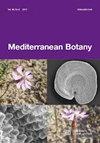揭示伊比利亚半岛东北部无柄栎林的保护和管理现状
IF 0.7
4区 生物学
Q3 PLANT SCIENCES
引用次数: 1
摘要
在伊比利亚半岛东北部发现的无根栎林属于lathyroa - quercetumpeeae组合,在了解该栖息地的生态方面发挥了关键作用,因为该地区代表了其干旱极限。为此,我们分析了该地区无根栎林的生物多样性格局和保护现状。为此,我们收集了随机分布在无根栎林中的34个样地的brun - blanquet清单。结果表明,气候条件与生物多样性变量之间存在一定的关系。随着温度的降低,群落的丰富度增加,而群落内的特征物种在相同温度下减少。这一结果是由于大多数伴生物种存在于高海拔的凉爽地带。无柄橡树被发现靠近其他社区,如银桦树和苏格兰松林。另一方面,在低海拔的温暖地区,无柄橡树群落更为成熟,具有典型的这种类型的森林植物。这些有无根橡树的稍微温暖的地区在保护方面非常重要,更容易受到气候变化和社区热干化的影响,正如已经研究过的那样。因此,保护和管理这些森林是保护这个群落的关键。然而,由于目前的保护措施不能保护这些森林中的大多数,因此必须确定一项保护战略来保护它们。根据伊比利亚半岛东北部无根栎林的保护现状,建立了改进该地区无根栎林保护策略的标准。本文章由计算机程序翻译,如有差异,请以英文原文为准。
Unveiling the conservation status of the sessile oak forest for their protection and management in the northeast of the Iberian Peninsula
The sessile oak forests found on the northeast of the Iberian Peninsula are ascribed to the Lathyro-Quercetumpetraeae association and play a key role in understanding the ecology of this habitat, as this region represents its xeric limit. For this reason, we analysed the biodiversity patterns and current conservation status of the sessile oak forests in the region. To do so, we collected Braun-Blanquet inventories of 34 plots randomly distributed throughout the sessile oak forests. The results showed a relationship between the climatic conditions and the biodiversity variables. While the richness of the community increased with decreasing temperatures, the characteristic species found within the community decreased at these same temperatures. This result was due to the presence of most companion species in the cool zones at high elevations.Sessile oaks are found close to other communities, such as silver birches and Scot pine forests.On the other hand, in the warm areas at low elevations, the sessile oak community was more established, with plants typical of this type of forest. These slightly warmer zones with sessile oaks are very important in terms of conservation and more vulnerable to climate change and the thermophilization of the community, as has been studied. As such, protecting and managing these forests is key to conserving this community. Nevertheless, as current protection measures do not safeguard most of these forests, it is essential to define a conservation strategy to preserve them. Using the conservation status, we have established criteria to improve the conservation strategy for sessile oak forest on the NE Iberian Peninsula.
求助全文
通过发布文献求助,成功后即可免费获取论文全文。
去求助
来源期刊

Mediterranean Botany
Agricultural and Biological Sciences-Plant Science
CiteScore
2.40
自引率
10.00%
发文量
30
审稿时长
12 weeks
期刊介绍:
Mediterranean Botany (ISSNe 2603-9109), formerly Lazaroa, is a biannual journal that publishes original research studies in the field of Botany including plant systematics, vegetation ecology, biogeography, evolutionary biology, ecophysiology, community ecology, ethnobotany and conservation biology on Mediterranean biomes but also in interacting areas.
Mediterranean Botany is an OPEN ACCESS Journal, free of charges for any published article.
 求助内容:
求助内容: 应助结果提醒方式:
应助结果提醒方式:


